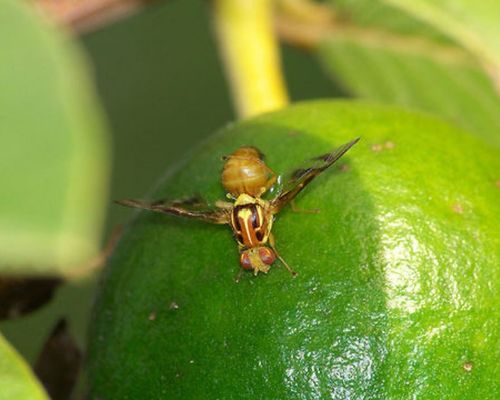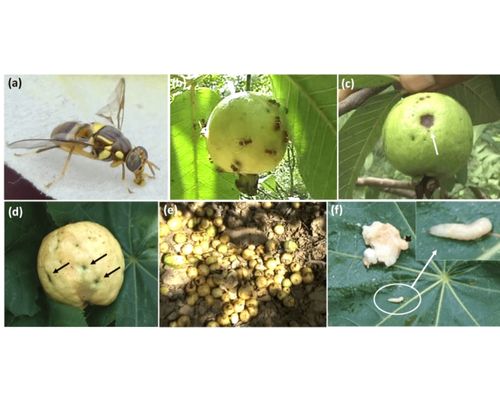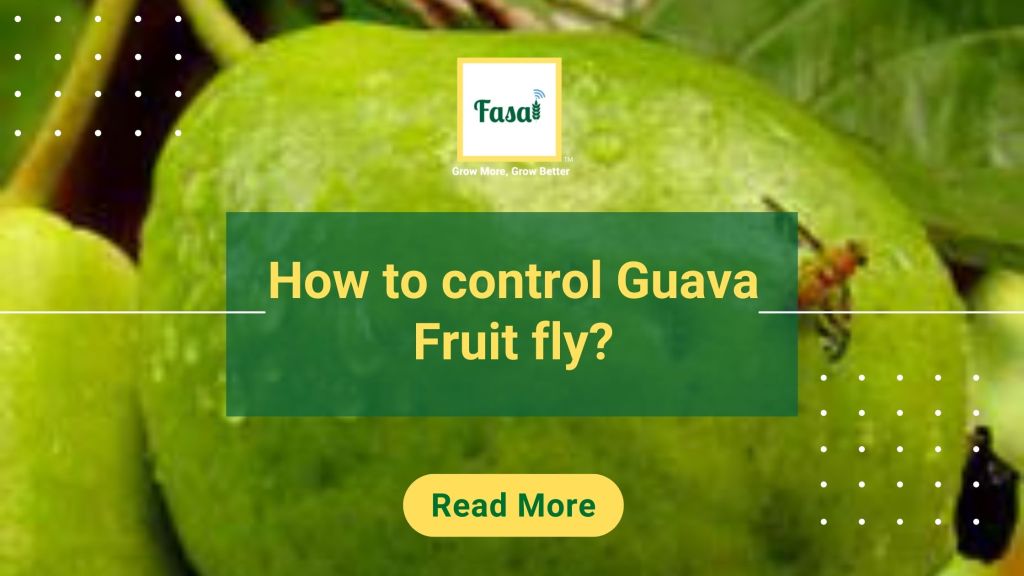This Blog carries information on how to identify a Guava fruit fly attack on your farm and how to tackle it effectively.
Guava is frequently referred to as a poor man’s apple in the tropics. It is well-known for its mouthwatering flavor, delightful perfume, and exceptional nutritional benefits everywhere it is grown. The fruit fly is a common insect pest known to cause significant losses and is a major barrier for growing high-quality fruits and vegetables. Fruit flies are among the most diverse and harmful pests on many tropical and subtropical fruits and vegetables. Guava fruit production is said to be severely damaged by fruit flies, which reduce yields and degrade produce quality.

Symptoms for guava fruit fly
- Guava fly attacks are usually by adults and larvae on semi-ripe fruits, causing the rotting of tissues.
- Maggots consume pulp and turn it into a foul-smelling substance.
- With the attack of guava fruitfly, fruits are turned into Semi-liquid, discolored mass.
- Adults are generally brown or dark brown in colour, with yellow legs and hyaline wings.
- Adult Fruit flies directly harm fruit by piercing the fruit’s skin to lay their eggs. Bacteria from the fly’s intestinal flora are transferred into the fruit during egg laying. These bacteria cause the rotting of the tissues surrounding the egg.

General preventive measures for guava fruit fly
- Gather and eliminate fruit that has fallen or is contaminated.
- Pupa gets exposed to the practice of summer ploughing. The exposure of insect pupae to the blazing sun during deep summer ploughing eliminates the pest from the field.
- To keep track of and eliminate adult fruit flies, use methyl eugenol lure traps (25 per hectare).
Tips for farmers to manage guava fruit fly infestation
Cultural control
Cultural control is the process of altering agricultural methods to minimize or stop crop damage from pests.
- Early harvesting of guava
Early fruit harvesting may help stop infestations, such as fruit fly attacks on almost-ripe fruits.
Farmers can prevent a fruit fly infestation by harvesting their crops at a stage of maturity when the fruit is resistant to attack.
- Sanitation practice
The population of fruit flies in the orchard is greatly reduced by regular cleaning and hygiene upkeep around fruit plants. To decrease the local fruit fly population, gathering and destroying fallen, infested, and overripe fruit is highly advised.
- Fruit bagging:
Fruit bagging during fruit development can lower the risk of physical damage and enhance colour during harvest. The best method for controlling guava fruit flies is to wrap individual fruits in transparent polypropylene bags with a piece of paper inside the polypropylene bag for partial sun protection.
- Trapping:
It is challenging to control fruit flies during their destructive larval stage because insecticides applied as dust or sprays cannot reach the target maggots. The best approach to deal with them is to catch adult flies in a trap before they start laying eggs or use insecticides to manage their populations. An efficient and safe way to reduce fruit fly populations is to use methyl eugenol lure traps to capture and kill adult guava fruit fly adults.
- Male annihilation technique, or MAT
Male Annihilation Technique (MAT) is a method of selectively attracting and killing male flies in which synthetic parapheromones are combined with insecticide and placed to a suitable substrate to allow delayed release. It is similar to the trapping technique.
Fruit flies can be attracted by methyl eugenol (ME), a male attractant, up to 800 meters away. The use of parapheromon-like methyl eugenol, together with the proper trapping approach, has also been found to be effective in monitoring, controlling fruit flies on broad areas using the male annihilation technique (MAT), and even completely eradicating certain fruit flies.

Chemical control:
- Since the damage caused by fruit fly larvae in fruits is internal, spraying insecticides on the canopy will not completely reduce the fruit fly infestation.
- However, insecticides can still be sprayed on crops during the vegetative phase, before blooming and fruit set stage to repel the adults. For spraying, one can use substances similar to malathion and methyl eugenol.
- For the convenience of farmers, the Fasal system offers timely recommendations for preventative spraying. One can avoid pest infestation by adhering to such recommendations.
How can Fasal Assist?
- The vicious Guava fruit fly may quickly and utterly devastate your crop in a matter of days. Fasal technology makes your guava fields safe from pests like fruit flies.
- The technology developed by Fasal, which is based on the idea of precision farming, keeps an eye on the crop, weather, and canopy conditions like leaf wetness to determine if there is any chance of fruit fly attack on your guava farm.
- In case of any possibility of attack, farmers receive alerts and preventative measures to control the pest population before it could cause any damage to the crop.
- Fasal technology, which is accessible 24/7, enables farmers to act on reason rather than instinct when making judgments.
- Our personalized advice lowers the need for pesticides, conserves crop quality, avoids unnecessary environmental damage, and reduces overall crop management expenses.
The technology developed by Fasal allows farmers to rest easy knowing that their crops are in good care.

Leave a comment